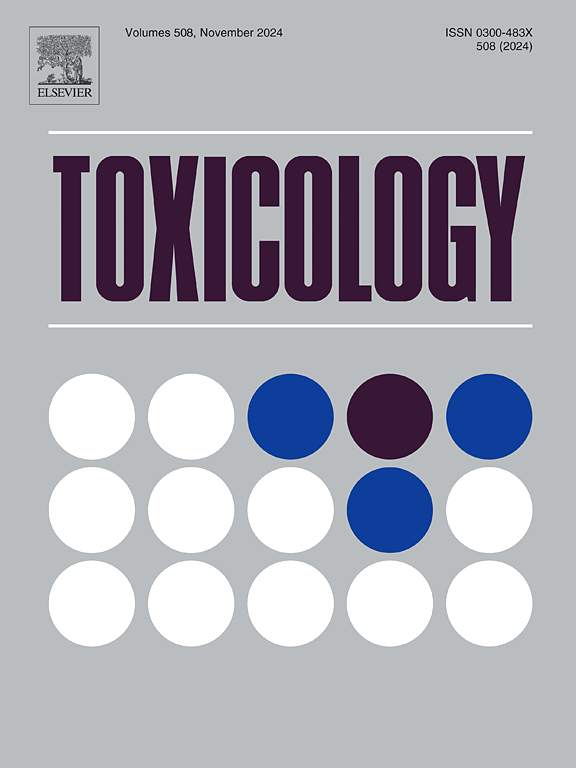Meg3-NONO-RAR axis mediates RA pathway activation in TCDD-induced cleft palate
IF 4.8
3区 医学
Q1 PHARMACOLOGY & PHARMACY
引用次数: 0
Abstract
Dioxins, a group of environmental pollutants, can cause developmental toxicity through interaction with the aromatic hydrocarbon receptor (AHR). Retinoic acid (RA) functions via binding to retinoic acid receptor (RAR)/retinoid X receptor (RXR). Both AHR and RA pathways can be activated by dioxins. TCDD or atRA exposure similarly alters the expression of the long non-coding RNA (lncRNA) Meg3 in mouse palatal tissue. This study further examined the mechanism of TCDD-induced cleft palate (CP) via the RA pathway in mouse embryonic palatal mesenchymal (MEPM) cells. Results showed that in MEPM cells TCDD treatment increased Meg3 and RARA expression, inhibited cell proliferation, and had a synergistic effect with atRA. RNA pull-down-MS and RIP assays revealed that Meg3 binds to NONO, which belongs to the drosophila behavior human splicing family (DBHS) and have been reported to be associated with cell cycle regulation. NONO interacts with RAR and inhibits RARA expression. TCDD and atRA treatment reduced NONO expression. Silencing Meg3 raised NONO levels and mitigated the impact of TCDD or atRA on RA pathway activation, cell proliferation and survival. These findings suggest that TCDD affects Meg3 and NONO expression and the RA pathway activation, Meg3 interacts with NONO which may regulate RARA in palatal tissue. Thus, we propose that the RA pathway activation in TCDD-induced cleft palate may be mediated by the Meg3-NONO-RAR axis.
Meg3-NONO-RAR轴介导tcdd诱导的腭裂RA通路激活。
二恶英是一类环境污染物,通过与芳烃受体(AHR)相互作用而引起发育毒性。视黄酸(Retinoic acid, RA)通过与视黄酸受体(Retinoic acid receptor, RAR)/类视黄X受体(retinoid X receptor, RXR)结合发挥作用。二恶英可激活AHR和RA通路。TCDD或atRA暴露同样会改变小鼠腭组织中长链非编码RNA (lncRNA) Meg3的表达。本研究在小鼠胚胎腭间充质细胞(MEPM)中通过RA通路进一步探讨了tcdd诱导腭裂(CP)的机制。结果表明,在MEPM细胞中,TCDD可提高Meg3和RARA的表达,抑制细胞增殖,并与atRA具有协同作用。RNA pull-down-MS和RIP实验显示Meg3与NONO结合,NONO属于果蝇行为人类剪接家族(DBHS),据报道与细胞周期调节有关。NONO与RAR相互作用,抑制RAR的表达。TCDD和atRA治疗降低了NONO的表达。沉默Meg3可提高NONO水平,减轻TCDD或atRA对RA通路激活、细胞增殖和存活的影响。这些结果表明,TCDD影响Meg3和NONO的表达以及RA通路的激活,Meg3与NONO相互作用可能调控腭组织的RARA。因此,我们认为tcdd诱导的腭裂中RA通路的激活可能是由Meg3-NONO-RAR轴介导的。
本文章由计算机程序翻译,如有差异,请以英文原文为准。
求助全文
约1分钟内获得全文
求助全文
来源期刊

Toxicology
医学-毒理学
CiteScore
7.80
自引率
4.40%
发文量
222
审稿时长
23 days
期刊介绍:
Toxicology is an international, peer-reviewed journal that publishes only the highest quality original scientific research and critical reviews describing hypothesis-based investigations into mechanisms of toxicity associated with exposures to xenobiotic chemicals, particularly as it relates to human health. In this respect "mechanisms" is defined on both the macro (e.g. physiological, biological, kinetic, species, sex, etc.) and molecular (genomic, transcriptomic, metabolic, etc.) scale. Emphasis is placed on findings that identify novel hazards and that can be extrapolated to exposures and mechanisms that are relevant to estimating human risk. Toxicology also publishes brief communications, personal commentaries and opinion articles, as well as concise expert reviews on contemporary topics. All research and review articles published in Toxicology are subject to rigorous peer review. Authors are asked to contact the Editor-in-Chief prior to submitting review articles or commentaries for consideration for publication in Toxicology.
 求助内容:
求助内容: 应助结果提醒方式:
应助结果提醒方式:


